By Melissa Dowland, Manager of Teacher Education, NC Museum of Natural Sciences
“Teaching a child not to step on a caterpillar is as valuable to the child as it is to the caterpillar.”
—Bradley Miller
Almost every fall of my 20-year long career at the Museum, I’ve helped organize the Caterpillarology station at BugFest. A small crew of folks scour our yards, greenways, native plant nurseries and other sites throughout the Triangle “caterpillar hunting” (collecting caterpillars to showcase at our table). It takes a bit of practice to notice the small details that hint at the presence of a leaf-muncher, and caterpillars come in a variety of shapes and colors, some of which can be quite camouflaged. Nonetheless, with about a week of work, we’re usually able to find upwards of 50 species of native, local caterpillars to share with guests at BugFest.
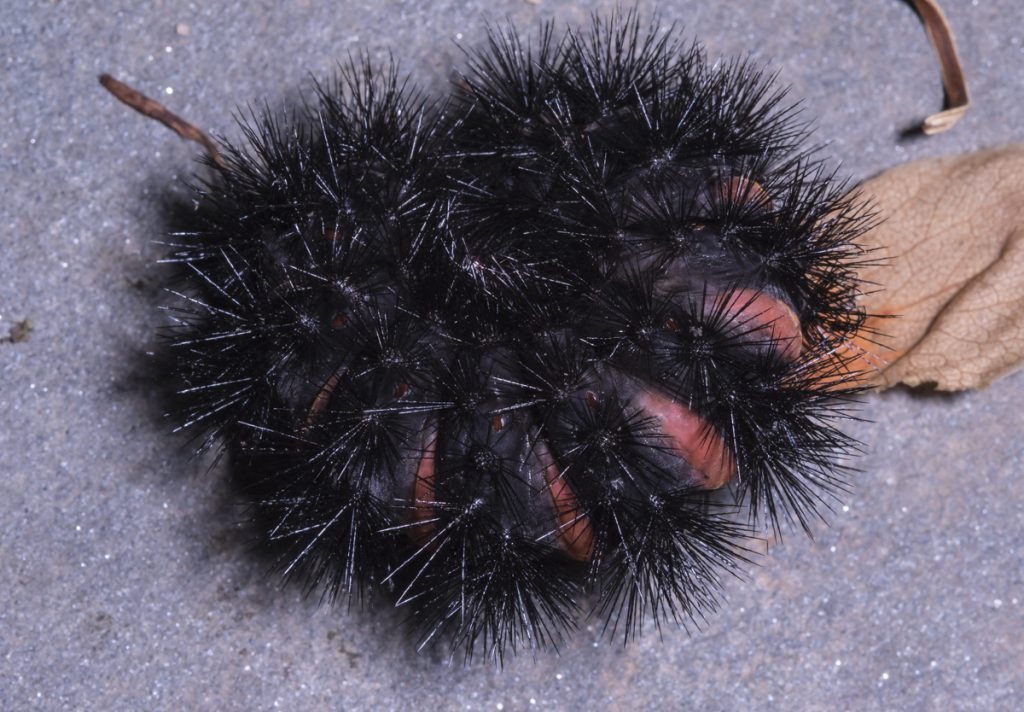 Giant leopard moth caterpillar curled up in its defense posture. This critter will be on the BugFest T-shirt this year, so we really hope we can find one! Photo: Mike Dunn.
Giant leopard moth caterpillar curled up in its defense posture. This critter will be on the BugFest T-shirt this year, so we really hope we can find one! Photo: Mike Dunn.
Caterpillars are the larval stage of butterflies and moths. A favorite reference of mine, a British field guide from the 1980s, describes caterpillars as cylinders “designed purely for eating and growing.” That truly is what they are. Their sole purpose in life is to eat as much as they can. So much, in fact, that they have to shed their skin (usually five times) to accommodate their growth. If a human baby grew as much as a caterpillar relative to its starting size, that baby would one day be as large as a whale! Growing that much also means generating a lot of waste. Frass, a favorite vocabulary word of middle school children everywhere, is the word for caterpillar poop. It’s usually a pellet that has striations in it, making it look a bit like a seed. A scattering of frass beneath a tree branch with some partially or completely eaten leaves clues us “caterpillarologists” in, making us pause to look more closely in the hopes of finding a big, juicy caterpillar.
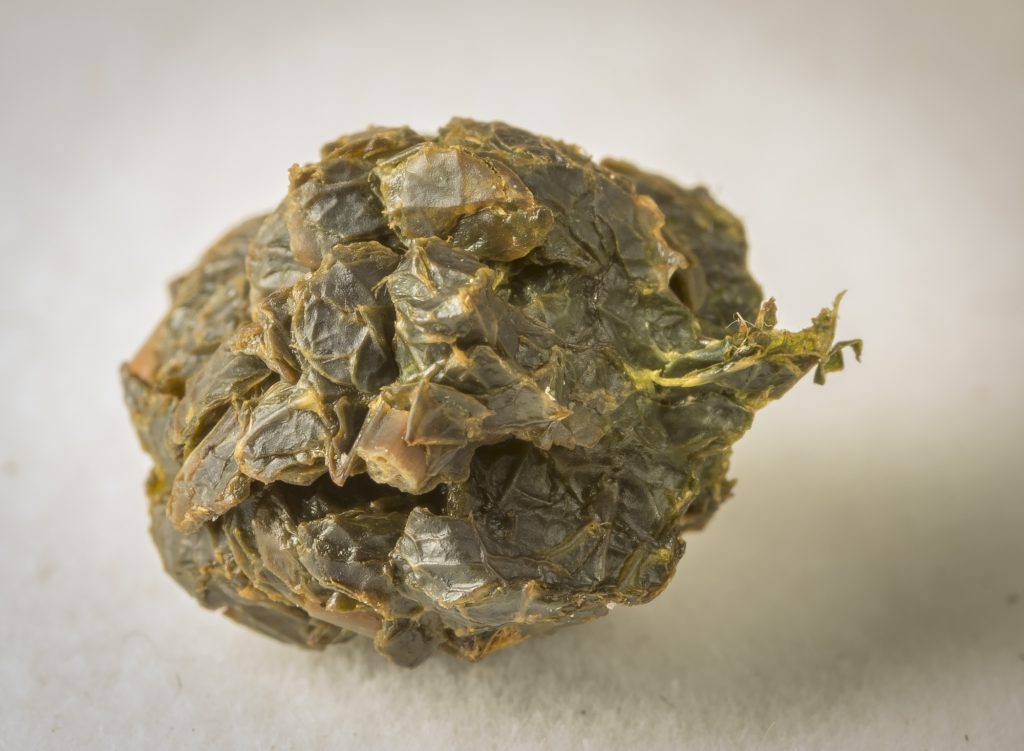 Close-up of a piece of caterpillar frass from a large cecropia caterpillar.
Close-up of a piece of caterpillar frass from a large cecropia caterpillar.
There are a few species of caterpillars that we seek each year, hoping to be able to show off their size or beauty or strangeness to guests at Bugfest. The holy grail of caterpillars is the hickory horned devil, the larva of the royal walnut moth. It’s the largest caterpillar in North America, maxing out at about the size of a hot dog. Its body is primarily green, but it has black-tipped orange spikes above its head, and smaller spines along the upper sides of its body. We don’t always have one of these beasts to show off at Bugfest, but when we do, it’s often due to the assistance of fellow caterpillar lover Billy Hartness, Superintendent of Weymouth Woods Sandhills Nature Preserve, who has an amazing ability to find them. (Thanks, Billy!)
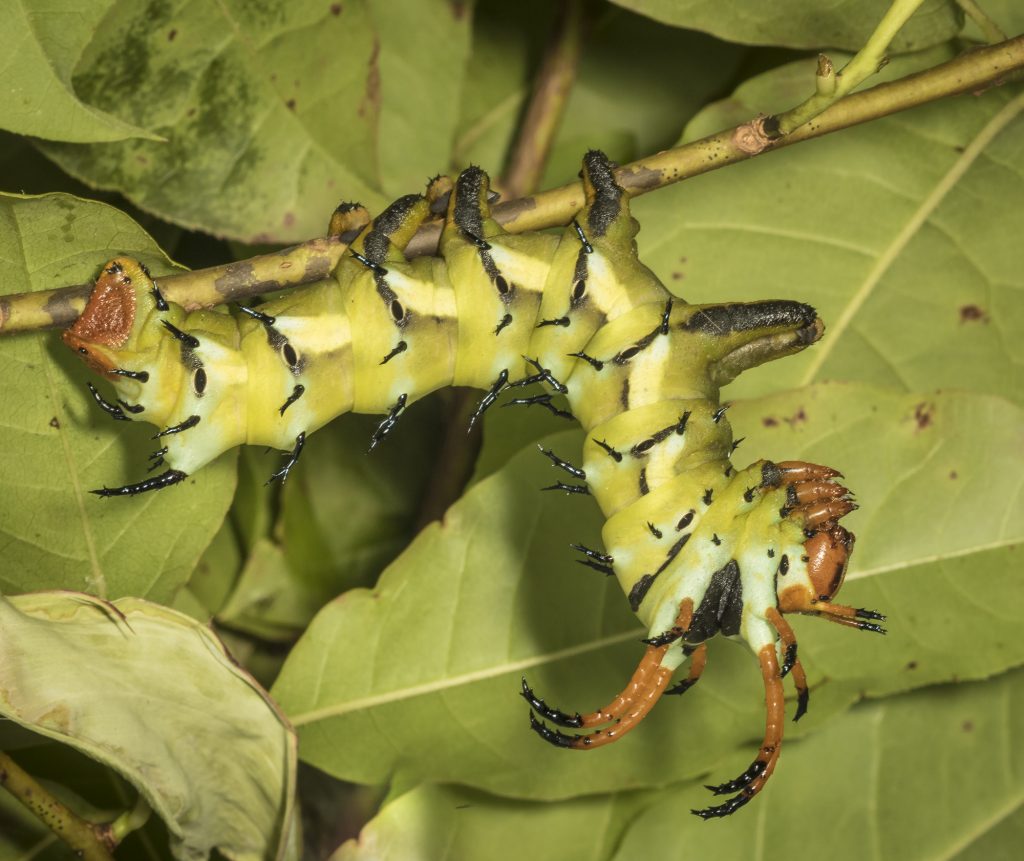 Hickory horned devil caterpillar. Photo: Mike Dunn.
Hickory horned devil caterpillar. Photo: Mike Dunn.
Another favorite is the monkey slug. It’s not a slug; it’s the caterpillar form of a hag moth. But you might not guess it was a caterpillar if you saw it hanging on a leaf above your head. Many caterpillars, like the Very Hungry one, have tubular green bodies. They have three pairs of true legs on their front end (these are the six legs that put them into the category of insects) and four to 10 prolegs towards the back of their body. The squishy prolegs are basically fleshy protuberances with comb-like grabbers for “feet” that help the caterpillar move and hold on to twigs and leaves. Slug caterpillars, by contrast, look more like a short, overturned canoe and their legs, both true and prolegs, are hidden under their body. They are often adorned with bright colors and bristly hairs that can sting if those bristles break off, releasing venom as your skin rubs against them.
The most common slug caterpillar is the saddleback, aptly named for the dark brown saddle across its middle. The most painful stings come from the puss caterpillar; it’s a bit hairier (not unlike a bad combover) with its stinging spines hidden beneath its coiffure. But the monkey slug is surely the strangest looking. This crazy caterpillar might remind readers of a certain generation of the classic “Barrel of Monkeys” game. But the monkey slug has a few extra arms, and it’s covered with short, tan hairs. A shout of joy goes up whenever we find one of these whacky cats!
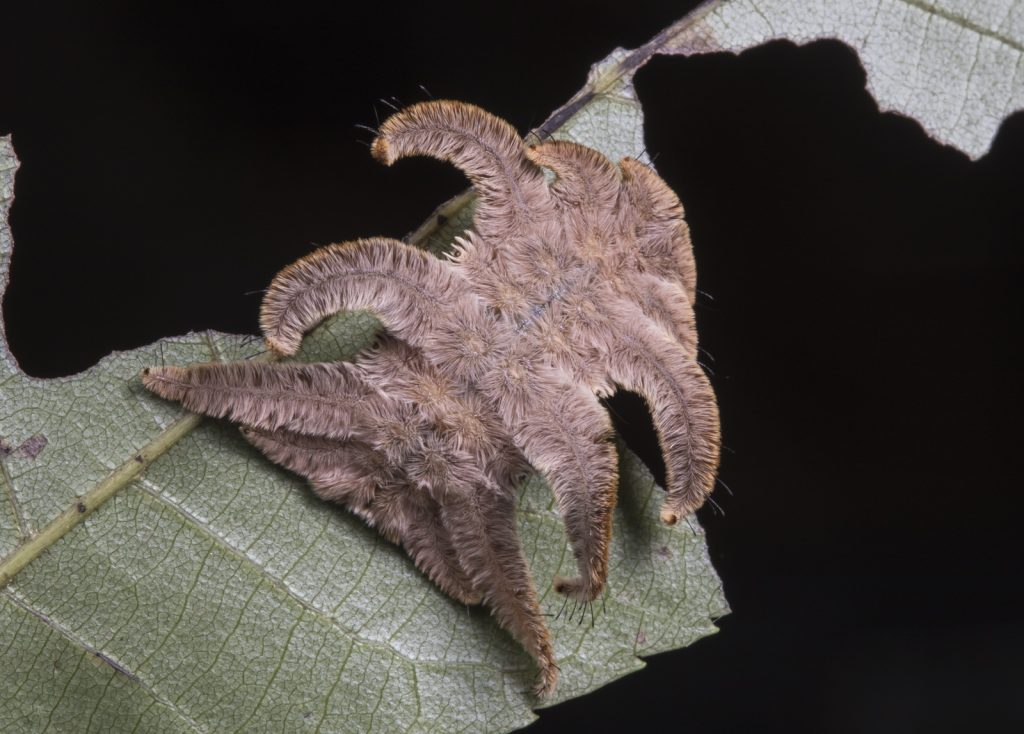 Monkey slug caterpillar. Photo: Mike Dunn.
Monkey slug caterpillar. Photo: Mike Dunn.
But enough about caterpillars because, as George Carlin once quipped, “The caterpillar does all the work but the butterfly gets all the publicity.” I think Mr. Carlin should have added that butterflies have better lobbyists, because folks tend to forget about (or worse, dislike) moths. The moths win the numbers game here: there are more than 2,900 species of moths in North Carolina versus a mere 177 species of butterflies. And many of our moths are colorful and beautifully patterned. Take the rosy maple moth, for instance, with its furry lemon-yellow body and baby pink and yellow patterned wings. It even has furry pink legs! And the day-flying snowberry clearwing moth looks like the gentler, cuter cousin of a bumblebee.
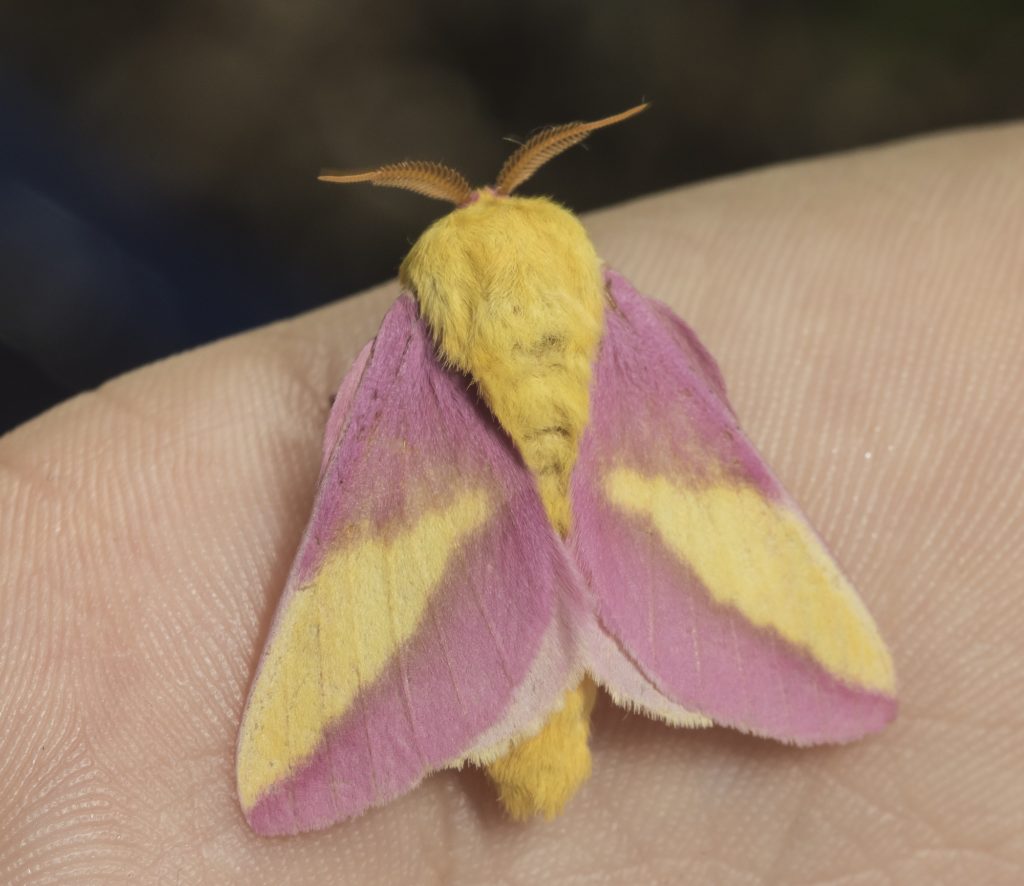 Rosy maple moth. Photo by Mike Dunn.
Rosy maple moth. Photo by Mike Dunn.
The difference between butterflies and moths turns out to be primarily a question of semantics. Though there are characteristics typical of one versus the other (day- vs. night-flying, clubbed vs. feathery antennae, colorful vs. not – which I’ve already disproved for you!), they’re all part of this year’s BugFest theme arthropod group, Lepidoptera. The term Lepidoptera comes from Greek, and means scale-winged, named for the colorful or patterned scales that give lepidopteran wings and bodies their colors. The actual definition of butterfly versus moth is that butterflies belong to six or seven specific families (part of superfamily Papilionoidea), and moths belong to the other 89+ families. And who cares about that but picky taxonomists? (Oh wait, those folks are my coworkers. Just kidding!)
But wait … I forgot the least-loveable phase of all, the pupa. Butterflies and moths go through complete metamorphosis, meaning they have a sedentary pupal stage where they don’t eat or defecate (but they can move a little, wiggling to help scare away predators). For butterflies, this phase is when they turn into a chrysalis, which is basically a naked pupa hanging from a leaf or branch (or perhaps the trellis in your garden). Many chrysalids are adorned with funky protuberances or metallic speckles; some are quite colorful while others might be a basic brown or green.
Moths either spin a cocoon, the silk-wrapped tree ornament that most folks are familiar with, or they dig into to the ground where they pupate in a soil chamber. If you’ve ever discovered something reminiscent of a tiny brown sarcophagus while digging in your garden, you may very well have found the pupa of a moth. Inside the pupa is where the magic happens: prolegs are absorbed, wings are formed and a feeding tube called a proboscis extends (or doesn’t … some adult moths do not have any mouthparts!). When ready, the pupa breaks open and the adult crawls out, climbs to a suitable spot to squeeze fluid out of its abdomen to pump up its wings, and rests to let its new exoskeletal parts dry before it can fly away.
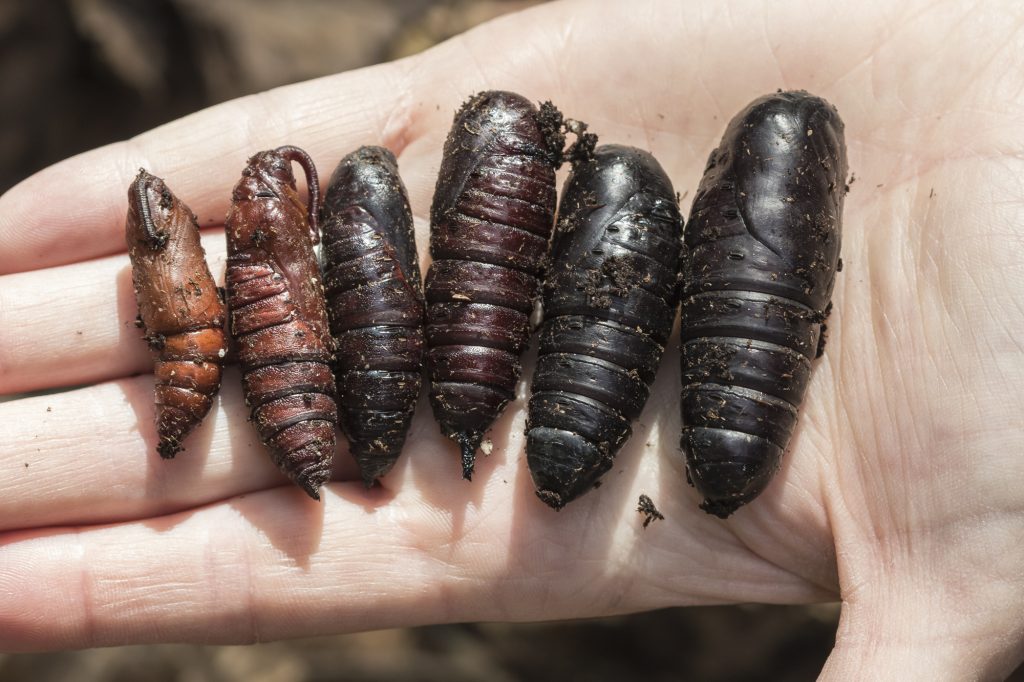 These six pupae, all from different species of moths, are from caterpillars that transformed after last year’s BugFest event! Photo: Mike Dunn.
These six pupae, all from different species of moths, are from caterpillars that transformed after last year’s BugFest event! Photo: Mike Dunn.
I hope all you readers who made it to the end of this lengthy (but hopefully entertaining) discourse on our lepidopteran neighbors will crawl out of your own pupae, dry out your wings and fly on over to BugFest on Saturday, September 14. And make sure you find our Caterpillarology station on Jones Street! We hope to stock it with even more strange and beautiful caterpillars than ever this year.
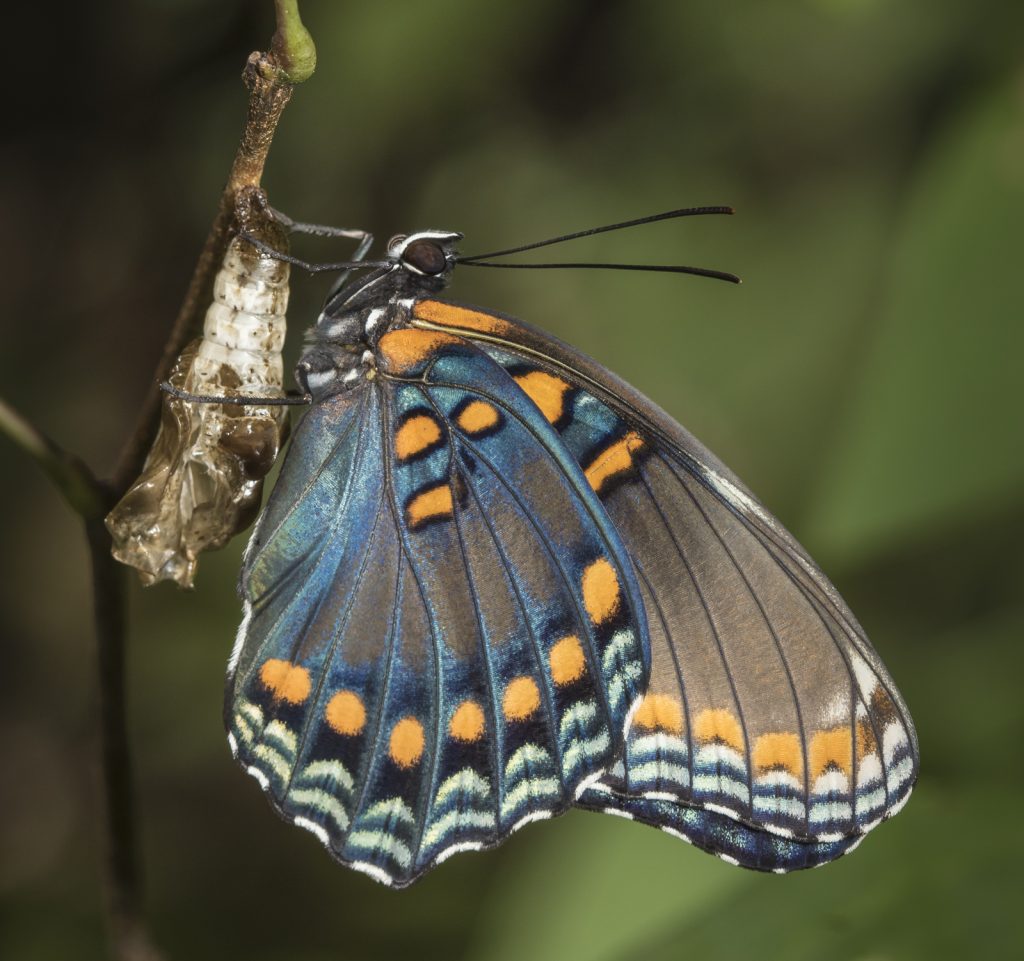 The red-spotted purple butterfly recently emerged from its chrysalis, which is on the twig next to it. This is a great ugly duckling story! Its caterpillar and chrysalis both look like bird poop, but the butterfly is stunning! Photo: Mike Dunn.
The red-spotted purple butterfly recently emerged from its chrysalis, which is on the twig next to it. This is a great ugly duckling story! Its caterpillar and chrysalis both look like bird poop, but the butterfly is stunning! Photo: Mike Dunn.

